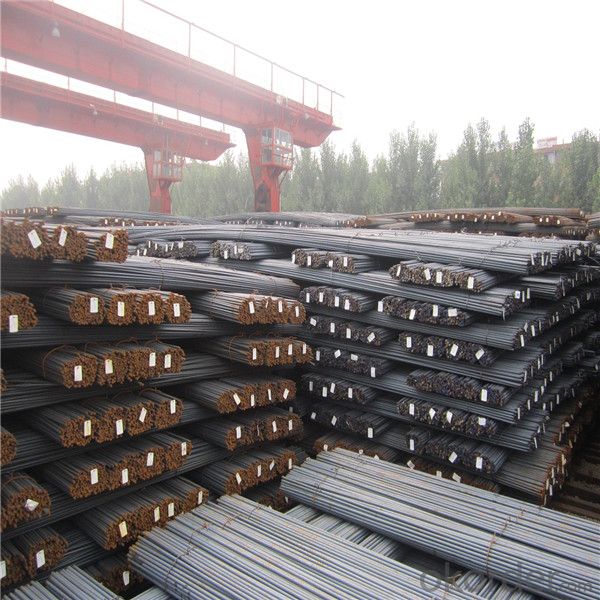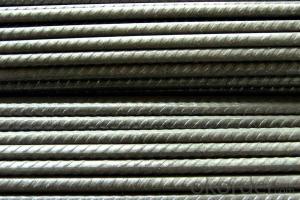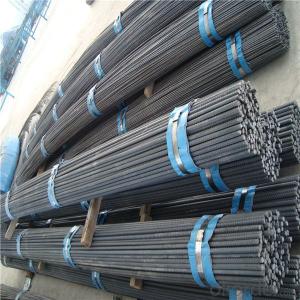Steel rebar from china 6-40MM in different grade
- Loading Port:
- Tianjin
- Payment Terms:
- TT OR LC
- Min Order Qty:
- 1000 m.t.
- Supply Capability:
- 17497 m.t./month
OKorder Service Pledge
OKorder Financial Service
You Might Also Like
Specification
Bars of steel commonly used in construction, especially for reinforcing concrete structures such as driveways,
foundations, walls, and columns. These bars come in different sizes and strength grades, and can be smooth
or may include deformations that provide greater adhesion for concrete poured over the bars. When used in poured
concrete, the bars are typically placed in a grid pattern, the concrete poured over them, and then readjusted to
maintain the proper shape while the concrete sets. Steel rebar can be purchased from a number of manufacturers
and is often found at construction retailers or large hardware stores
Most grades of steel used in rebar cannot accept welding; such as, to adjacent steel plates or as means to bind
single pieces of rebar together. However, special grades of rebar steel and welding rods make welding by expert
welders possible.
To prevent workers from accidentally impaling themselves, the protruding ends of steel rebar are often bent over or
covered with special plastic "mushroom" caps.
Product Description :
Chemical composition (%): | Steel | C | Si | Mn | P | S | Ceq | ||||
HRB335 |
0.25 |
0.80 |
1.60 |
0.045 |
0.045 | 0.52 | |||||
HRB400 | 0.54 | ||||||||||
HRB500 | 0.55 | ||||||||||
Mechanical properties | Steel | Rel/ MPa | Rm/ MPa | A/ % | Agt/ % | ||||||
≥ | |||||||||||
HRB335 | 335 | 455 | 17 |
7.5 | |||||||
HRB400 | 400 | 540 | 16 | ||||||||
HRB500 | 500 | 630 | 15 | ||||||||
Package: | Standard export packing or as customer's request | ||||||||||
Application: | Construction, building, bridge, road. ect | ||||||||||
Payment terms | 1).100% irrevocable L/C at sight. | ||||||||||
Delivery time | 15-30 days after receipt of L/C or deposit by T/T | ||||||||||


Features
1、Pure steel quality, stable chemical contents, small tolerance.
2、Constant Quality, good drawing performance.
3、High dimension accuracy degree, accuracy degree of Level C up to 80%, smooth surface, less scale, easy to be pickled.
4、Automatic bundling with 4 lines by Machine in tidy and good looks
5、Big high quality percentage, small coil percentage, and heavy coil weight for Hard Coil.
6、High sorbitizing percentage.
Packing:
In bundles, each bundle weight 3.5 tons. Load by container or by bulk verssel.


FAQ:
1.Q: What's your MOQ(minimum order quantity)?
A: One full container, mixed acceptable .
2. Q: What's your packing methods?
A: Packed in bundle or bulk ..
3. Q: How can I buy CNBM products in my country?
A:Please send us an inquiry or email ,we will reply to you if there is distributor in your country
4. Q: Can we visit your factory?
A: Warmly welcome. Once we have your schedule, we will arrange the professional sales team to follow up your case.
5. Q: How long does it take to get the product if i place an order?
A:With the process of your requirements,we will pack and deliver in 3-7 days. If it is by sea shipment,it will take 15-45 days depending on different locations
- Q: What are the guidelines for the proper lap splicing of steel rebars?
- The guidelines for the proper lap splicing of steel rebars include ensuring that the rebars are clean and free from rust, dirt, or any other contaminants. The spliced rebars should have appropriate overlapping lengths as specified by the design engineer. The lap splice should be made using mechanical splicing methods or approved splice connectors to ensure proper load transfer. The spliced rebars should be securely positioned and aligned to maintain the required concrete cover. It is essential to follow the specific codes and standards set by the construction industry for lap splicing to ensure the structural integrity and safety of the reinforced concrete structure.
- Q: Are steel rebars easy to work with?
- Steel rebars can be both easy and challenging to work with, depending on the specific task and the individual's experience and skill level. In general, steel rebars are known for their strength and durability, making them a popular choice in construction projects. They are relatively easy to handle and manipulate due to their uniform shape and standardized sizes. However, working with steel rebars also requires certain precautions and techniques. Cutting and bending rebars can be physically demanding and may require specialized tools such as rebar cutters and benders. Additionally, the weight of rebars can be a challenge, especially when dealing with longer and thicker pieces. Furthermore, proper safety measures need to be followed when working with steel rebars. Wearing protective gear, such as gloves and goggles, is crucial to prevent injuries. Attention must also be paid to avoid any potential hazards, such as sharp edges and protruding rebars. Overall, while steel rebars can be relatively easy to work with for experienced professionals, they may present challenges for individuals with limited knowledge or tools. It is recommended to seek proper training and guidance when working with steel rebars to ensure safety and achieve precise results.
- Q: Can steel rebars be used in pre-tensioned or post-tensioned structures?
- Steel rebars can be used in both pre-tensioned and post-tensioned structures. In pre-tensioned structures, rebars are pre-stressed before the concrete is poured, while in post-tensioned structures, rebars are stressed after the concrete has hardened. The use of steel rebars provides strength and reinforcement to the structures, making them suitable for both pre-tensioned and post-tensioned applications.
- Q: How are steel rebars different from other types of reinforcement?
- Steel rebars are different from other types of reinforcement primarily because they are made of steel, which gives them high tensile strength and durability. Unlike other materials like wood or concrete, steel rebars can withstand heavy loads and provide structural integrity to reinforced concrete structures. Additionally, steel rebars can be easily molded and shaped into various designs, making them versatile and suitable for different construction applications.
- Q: What is the process of reinforcing concrete walls with steel rebars?
- The process of reinforcing concrete walls with steel rebars involves several steps. First, the design and placement of rebars are determined based on the structural requirements. Then, the concrete wall is prepared by cleaning and ensuring a strong bond with the rebars. Next, the rebars are cut and bent according to the specified dimensions and patterns. These rebars are then placed in the desired positions within the formwork, ensuring proper spacing and alignment. Once the rebars are in place, the concrete is poured, encapsulating the rebars and forming a solid structure. The concrete is allowed to cure and harden, creating a reinforced concrete wall that is stronger and more resistant to cracking or structural failure.
- Q: What are the different types of steel rebars used in precast concrete constructions?
- There are several different types of steel rebars commonly used in precast concrete constructions. These rebars are designed to provide reinforcement and increase the strength and durability of the concrete structure. 1. Mild Steel Rebars: These are the most commonly used type of rebars due to their affordability and easy availability. They have a low carbon content and are suitable for most precast concrete applications. 2. High Strength Deformed (HSD) Rebars: These rebars have a higher yield strength compared to mild steel rebars. They are made by hot rolling process and have deformations on their surface to provide a better grip with concrete. HSD rebars are commonly used in heavy-duty structures or where additional strength is required. 3. Carbon Steel Rebars: Carbon steel rebars are made from carbon steel alloys and have a higher carbon content compared to mild steel rebars. They offer improved strength and durability and are often used in precast concrete constructions that require high tensile strength. 4. Epoxy-Coated Rebars: These rebars are coated with an epoxy layer to protect them from corrosion and increase their lifespan. Epoxy-coated rebars are commonly used in precast concrete constructions that are exposed to harsh environments or have high moisture content. 5. Stainless Steel Rebars: These rebars are made from stainless steel alloys, which provide excellent resistance to corrosion. Stainless steel rebars are used in precast concrete constructions that are exposed to corrosive substances, such as seawater or chemicals. It is important to select the appropriate type of rebar for a precast concrete construction based on the specific requirements of the project, including the load-bearing capacity, durability, and environmental conditions. Consulting with a structural engineer or a construction professional can help determine the best type of rebar for a particular application.
- Q: How to judge the quality of thread steel?
- First of all, to see if there are rebar factory quality certificate and inspection report
- Q: What are the guidelines for the proper anchoring of steel rebars in walls?
- The guidelines for proper anchoring of steel rebars in walls typically involve factors such as the rebar size, spacing, embedment depth, and the type of wall construction. It is important to follow building codes and structural engineering standards specific to your region. Generally, rebars should be adequately spaced and securely anchored into the surrounding concrete or masonry to ensure proper load transfer and structural integrity. Additionally, proper cover thickness should be maintained to protect rebars from corrosion and ensure long-term durability.
- Q: What is the effect of chloride ions on steel rebars?
- The presence of chloride ions in the environment can have a detrimental effect on steel rebars. Chloride ions can penetrate the protective oxide layer on the surface of the steel and react with the iron atoms, leading to the formation of iron chloride compounds. These compounds are highly corrosive and can cause the rebars to rust and eventually weaken. This corrosion process, known as chloride-induced corrosion, can significantly reduce the structural integrity and lifespan of steel rebars, posing a risk to the overall stability of reinforced concrete structures. Therefore, it is crucial to protect steel rebars from chloride exposure through proper design, construction, and maintenance practices to ensure their long-term durability and safety.
- Q: Can steel rebars be used in the construction of residential towers?
- Yes, steel rebars can be used in the construction of residential towers. Steel rebars provide strength and durability to reinforced concrete structures, making them an ideal choice for high-rise buildings like residential towers. They help reinforce the concrete and enhance its load-bearing capacity, ensuring the structural integrity and safety of the construction.
Send your message to us
Steel rebar from china 6-40MM in different grade
- Loading Port:
- Tianjin
- Payment Terms:
- TT OR LC
- Min Order Qty:
- 1000 m.t.
- Supply Capability:
- 17497 m.t./month
OKorder Service Pledge
OKorder Financial Service
Similar products
Hot products
Hot Searches
Related keywords


























